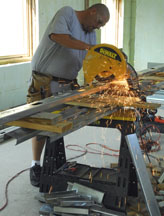
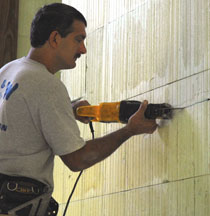


Steel Framing in the Ventura-Gutek ICF House
| Although most of the inner walls of the house were made with concrete-filled ICF blocks, a few walls were framed with 16 gauge steel. We chose steel because it does not mildew or rot and the studs and joists are straight and strong. | |||
 |
 |
 |
 |
| The first studs were installed by H & W Construction of Alpine, TN. Bobby Perry used a chop saw to cut a 4" metal stud with an 11" metal-cutting blade. | In order to screw an 8" track to the concrete wall, Mike Hunley the co-owner of H & W Construction (not recommended) cut into the foam block with an electric saber saw, then removed it with the claw of his hammer. That track was then attached to the concrete wall with Tapcon screws. (If metal plates had been installed by the concrete subcontractor before the wall was poured, the track could have been screwed directly to them.) | The 4" steel track was secured to the concrete floor with TrakFast nails. | |
 |
 |
 |
Self tapping Phillips half inch wafer head sheet metal screws join the studs and track together. |
||
 |
 |
 |
 |
|
This wall has a doorway and three high windows. |
Glue was applied to the studs, then flooring was laid down and screwed in place over it. | ||
| Why don't we recommend Mike Hunley and his H & W Construction Company? His bid was very high, but he was recommended by the steel supplier and assured us that he could handle the job without engineered plans. He told us that the high price included extra material - but not to worry - because he would reimburse us for any unused materials. He promised to give us a written agreement before starting the job but only provided an invoice after the work was done. The building inspector and structural engineers were later shocked by his faulty work. Mike attached most of the track (that supports the joists) to the plastic inserts in the ICF wall with sheet rock screws! He agreed to fix some things, like adding headers over openings on load bearing walls and adding more screws to the ends and joins of the pieced joists and said he would replace the structurally unsound joists if I provided him with engineered plans. Even after obtaining expensive engineered plans, he never fixed anything. Mike said that he pieced together the joists and track to save material. Over $1200 of new joists and track were left over, but we were not reimbursed. Mike promised to reimburse our expenses to fix everything, but after a year of broken promises, I successfully sued him in small claims court. Mike didn't show up in court and to date, I have not received a penny from him! The Board for Licensing Contractors of TN fined him $500 for incompetence in July of 2010. | |||
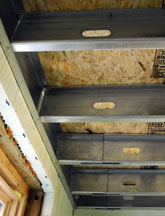 |
 |
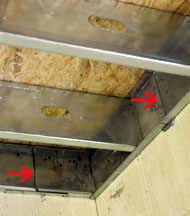 |
 |
|
I can live with the holes that don't line up in the joists and studs (a problem for the plumbers and electricians), but the lumpy joints on the left make the above floor uneven and are problematic for the sheet-rockers. The bottoms of these same joists were cut to clear an ICF wall - making them structurally unsound. One joist was even cut on top in two places. The brackets that support them are also unsound. These 8" joists were later replaced with 6" joists. |
Mike literally cut corners here - piecing the joist and track, then not sufficiently securing either to the corner of the wall. The lumpy joint created a bulge in the floor above and is a problem for the sheet-rock below. | The bottom of the pieced joist on the left that supports the edge and corner joists (not shown) of the floor above needed to rest on the stud wall. More screws and cross braces were later added to secure this joist. | |
| After waiting months for Mike Hunley to fix and finish the job, Andrzej decided to do it. He bought a chop saw, a metal cutting blade, a magnetic level, and a locking C-clamp and actually did a great job! | |||
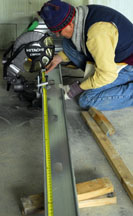 |
 |
 |
 |
|
"Measure twice, cut once," my mother would say. |
A clamp secured the track to the stud while being screwed. | A level helped keep the stud plumb. | |
Link to footer and slab construction.
Link to ICF wall construction.
Link to construction of second floor.
Link to construction of walls of second story.
Link to ICF roof construction.
Link to stovepipe installation.
Link to insulated rubber roof installation.
Link to the window and door installation.
Link to steel stairs installation.
Link to brick laying.
Link to overhang installation.
Link to gutter installation.
Link to electrical work.
Link to plumbing installation.
Link to septic tank installation.
Link to sheetrock/drywall installation.
Link to mudding / sheetrock finishing.
Link to painting of the walls and ceiling.
Link to the installation of the floor tile.
Link to the installation of the flexible solar panels.
Back to the ICF main page.
Web page, text, and photographs by Carol Ventura in 2008.